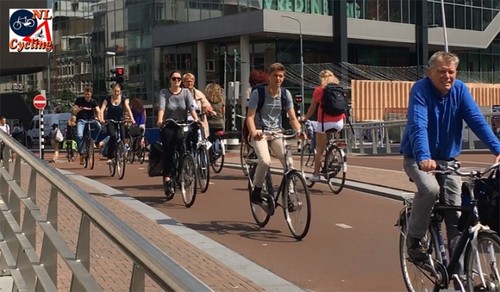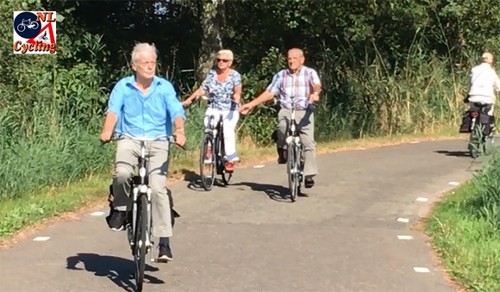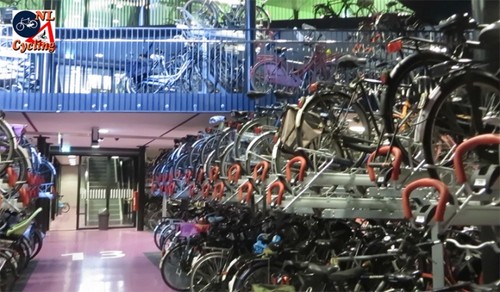 Cycling in Dutch cities increases 12% from 2005 to 2016. (Photo: bicycledutch.wordpress.com) Cycling in Dutch cities increases 12% from 2005 to 2016. (Photo: bicycledutch.wordpress.com)
|
Cycling has impressed any visitors to the Netherlands.
“I was overwhelmingly impressed by the large number of bikes I saw. They make parking very easy. And the rules and regulations guiding their movement around town to avoid accidents I think is really impressive,” said Sade Orimolade from Nigeria.
“There are all these bikes. The cyclists just keep coming and coming...and keep coming from both directions. It’s something really spectacular to see,” said Afton from Canada.
“It’s amazing. I saw it as a public protest against the increasing world prices. Even people in full suits use bicycles,” said Vajira Perera from Sri Lanka.
“Bikes are a way of life there, aren’t they? I like the way the Dutch have worked out a system. As things get smaller in vehicles they have more rights,” said Judith from the UK.
 The aging population contributes significantly to the growth of cycling in the Netherlands. The aging population contributes significantly to the growth of cycling in the Netherlands. (Photo: bicycledutch.wordpress.com)
|
With its 23 million bicycles outnumbering its 17 million people, the Netherlands is a rare country. The beautiful bicycles-only lanes in the Netherlands fill visitors with admiration and wonder. But it hasn’t always been like that.
In the 1950s and 60s, cyclists were under severe threat of being expelled from Dutch cities by the growing number of cars.
But in the 1970s, the number of traffic casualties rose. In 1971 more than 400 children were killed in traffic accidents. That was followed by a global oil crisis in 1973 that caused gasoline prices to skyrocket.
These events, together with the relentless efforts of environmental activists, led to the Netherlands becoming what it is today: the bicycle capital of the world.
 Marijke Koeman conducts an interview during a documentary festival in the Netherlands. Marijke Koeman conducts an interview during a documentary festival in the Netherlands. |
Marijke Koeman, a retired Dutch journalist and dedicated cyclist, said, “Cycling became a culture in this country not that long ago, in the 70s of the last century. It’s when people noticed that cities and roads were all aimed at cars, while so many Dutch people were also cycling.”
“So people were telling the government to also think of cycle lanes. At that time, we started to organize traffic, not only for bikes or for cars, but especially for bikes. It was only in the 70s that it became a real culture,” Marijke added.
The popularity of cycling in the Netherlands is undoubtedly aided by the fact that it’s a flat, compact, densely populated country with a climate that’s mostly moderate. But above all, cycling has incomparable advantages and benefits, said Marijke.
“Since the 17th century it’s been much easier to travel through the Netherlands because the infrastructure is now also looking at safe lanes for cycling. Sometimes it’s quicker in big cities to take your bike than your car,” Marijke explained.
“You don’t have parking problems. It doesn’t cost any petrol and you are out in the open air and you are moving so you are staying healthy.”
Today there are some 400 kilometers of bicycle paths criss-crossing Amsterdam, with an estimated half of all city journeys taking place on two wheels.
It’s estimated that Dutch people, on average, cycle 1,000 kilometers per year, a statistic boosted by teenagers, who cycle up to 2,000 kilometers per year.
“Young people ride their bike a lot. It gives them freedom. But one important thing you notice is that children are taught how to behave in traffic when they are very young,” said Marijke.
“At school, they even have examinations on traffic and then they go into the streets and show that they know what the rules are to ride a bike. It’s one of the first diplomas children get at a young age and then, of course, going to school on the bike is easy.”
 A bicycle parking area in the Netherlands. (Photo: bicycledutch.wordpress.com) A bicycle parking area in the Netherlands. (Photo: bicycledutch.wordpress.com)
|
Marijke got rid of her own car several years ago because she didn't want to pollute the environment. And this is a key reason why cycling has been increasingly popular in the Netherlands.
“One very important aspect of cycling in the Netherlands in the last few years is the environment. We’ve come to learn that the environment is much better if you use a bike, not a car, because it doesn’t pollute the air, it doesn’t make noise, and it doesn’t take up too much space. Those are the big advantages of cycling,” she said.
While cycling is a sport in many countries, it is an indispensable part of life in the Netherlands. There, 70% of all journeys less than 7.5 km are made on a bicycle. You can hardly find it in any other countries. It’s in Holland, isn’t it?